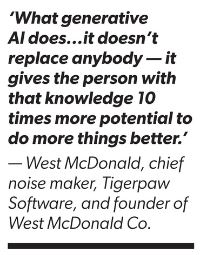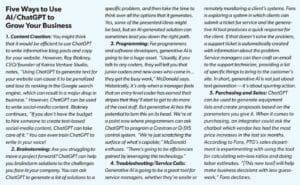Generative AI tools have been one of the hottest topics in the business world since OpenAI launched ChatGPT at the end of November 2022. Integration firms, enterprises and end users are now excitedly researching how they can use this powerful AI chatbot to automate daily tasks, streamline operations and amplify work output.
Many of our foremost thought leaders perceive generative AI as one of the most disruptive technological paradigms shifts of our time. Bill Fons, president of Wixom, Mich.-headquartered integration firm Promotion Technology Group (PTG), compares it to the birth of the internet. He notes the immense benefits that generative AI has to offer across industries and, in particular, in commercial AV.
To put things in perspective as regards just how quickly this technology is growing, ChatGPT hit an estimated 100 million monthly active users in January 2023, making it the fastest-growing application in history. TikTok took nine months to reach 100 million users, whereas Instagram took two-and-a-half years.
CI consulted with three industry thought leaders to get their insights on generative AI and how it will impact the AV integration industry. This article weaves together their insights, analysis and perspective.
The Differences between AI and Generative AI
Let’s take a step back and look at the differences between artificial intelligence (AI) generally and generative AI specifically.
“AI” is a term that’s familiar to AV professionals. Think of Poly’s AI-powered cameras or Bose’s noise-canceling headphones. Generative AI is much different. According to West McDonald, chief noise maker, Tigerpaw Software, who is also founder of West McDonald Co., what AI doesn’t do is have a human touch. “In other words, you can’t ask a Bose speaker a question or get it to reset its parameters by talking to it,” he explains. “That’s one of the things that’s going to change. You’ll be able to have a conversation with whatever the system is, and that could be five or six components of things.”
 McDonald continues the thought, saying, “I think the idea of artificial intelligence is the wrong way to look at [generative AI]. Unfortunately, the name has already been established — [but] it’s more like augmented intelligence. What generative AI does…it doesn’t replace anybody — it gives the person with that knowledge 10 times more potential to do more things better.” He adds, “Most people don’t understand that there’s probably five or six different flavors of AI. If you look at IBM Watson, that’s been around for a long time, but that’s not a natural language processing engine. This is entirely unique to the world.”
McDonald continues the thought, saying, “I think the idea of artificial intelligence is the wrong way to look at [generative AI]. Unfortunately, the name has already been established — [but] it’s more like augmented intelligence. What generative AI does…it doesn’t replace anybody — it gives the person with that knowledge 10 times more potential to do more things better.” He adds, “Most people don’t understand that there’s probably five or six different flavors of AI. If you look at IBM Watson, that’s been around for a long time, but that’s not a natural language processing engine. This is entirely unique to the world.”
Blaine Brown, principal consultant at global integration firm Diversified, agrees with the distinctions being made. “AI-powered devices aren’t generative AI — it’s just AI,” he opines. “Machine-learning-level devices like smart cameras, audio DSPs and stuff like that make acoustics better. All that technology improves the equity in the room and the user experience.”
Conceptual Technical Design
Turning back specifically to tools based on generative AI, integrators shouldn’t shy away from adopting them. Recognizing one worry, Fons says, “I don’t think it’s going to eradicate anybody. But it is going to give us more time to do more strategic-level work with our customers versus just busywork.”
“Needs assessments and space evaluations are typically done by those with trained expertise and experience because they’ve been there, done that and learned some of the best ways to do things,” McDonald explains. “What generative AI is going to allow them to do is to take that corpus of information and start being able to take on a lot of those manual processes.” He continues, “Once they have the parameters of a space and then extract [them] through some kind of application, it’ll start to look at what the recommendations are for those spaces.” McDonald predicts transformations like this are going to happen a lot faster than most people would expect.
Related: AI Chat Interface from 22Miles Wins Big at InfoComm 2023
A natural language processing engine, which is what ChatGPT is based on, is highly efficient at moving through tech specs and features. McDonald notes that one could ask ChatGPT how fast an HP LaserJet 4250 is, as well as its capabilities with respect to monthly volumes. Now, if you asked a colleague the same question, they probably wouldn’t know the answer right away. ChatGPT has the capability to answer questions instantaneously. “If you think of a similar piece of equipment that [integrators] would be installing in a commercial space, it will already know [the statistics and product capabilities],” McDonald declares. “All we have to do then is compare it with what the customer needs, the conceptual design and the space evaluation. It’ll make it much faster to select the kinds of equipment that work together and that satisfy what the customer is looking for.”
ChatGPT’s Integration with Platforms
Diversified’s Brown predicts that generative AI is going to be invaluable when it comes to predictive maintenance. If ChatGPT is integrated into a business’ day-to-day platforms, then integrators can ask it questions about the organization’s own data. Examples of questions might include these: Which devices have experienced the most issues over the last quarter? Which devices are due for a firmware update? It’s even plausible to ask ChatGPT for its prediction on any sort of potential failures, based on past performance trends. Generative AI could start predicting when devices need to be replaced, eliminating the need for integrators to do quarterly or twice-yearly client site visits.
Speaking of his role at Diversified, Brown says, “There’s a lot of data we collect for our customers [where] we’ve rolled out monitoring, or we have a pulse on a proactive monitoring service. We collect a lot of data around all the AV devices that are connected in a room [and] the performance of those….” He continues, “When you have that much data around device performance, it’s just waiting to be exploited by a learning language model (LLM) or integrated with a chat feature so you can chat with your data.”
Brown posits that generative AI could even be used to identify your firm’s most profitable projects. “It has the potential to even create a summary as to why those projects were profitable,” he explains. “It also has the capability to [identify] which suppliers have the longest delivery time.” Brown adds, “The data is there. We might as well chat with it. That’s where I think we’re heading as an industry.”
Integrators shouldn’t fret about these changes; rather, integrators should see an opportunity. As Brown explains, “With any major technological evolution, there’s complexity. And even though the potential outcome for the end user is to make them more efficient — make them be able to chat with something — there’s all the underlying technology that still needs to be figured out.” He cites, for example, all the data repositories and how an organization can leverage them. “These are the kinds of conversations integrators need to be having with clients,” Brown advises, “because clients are already looking at this technology.”
“As integrators, we need to be able to have intelligent conversations within our bubble on how we can leverage these trends to make the services we provide better,” Brown continues. “And, in turn, make the user experience better.”
The Challenges of Generative AI
When the first iteration of ChatGPT came out, there was much skepticism. The output was oftentimes fanciful, made-up answers. It was almost as if the chatbot was hallucinating. Many of those issues are now substantially resolved. “With Bing integration, the hallucinations are almost nonexistent,” Fons says. “Anytime you’re looking for stuff, [it gives you] references to websites where it got the information. You can fact-check it.” And he suggests that users do exactly that. “No matter what you’re doing — if it’s for social-media posting, marketing or sales efforts, or assisting you with tactical design or space evaluation — fact-check it now,” Fons implores.
McDonald notes a key fact: Yes, generative AI can make mistakes and do things incorrectly. “It can say [a product] could work with [another product], when, in fact, it doesn’t, for example,” he acknowledges. However, he’s quick to add that this is now the exception, rather than the rule. “It’s something to be aware of,” McDonald concludes, adding a note of optimism that things will only continue getting better.
It’s worthwhile to contextualize generative AI’s inaccuracies. After all, you could be talking to a colleague who gives you incorrect information. “It’s never going to go away because [generative AI] is built on human language,” McDonald concedes. “And guess what? To err is human. And that’s going to continue to be the case for anything that we build.” However, he believes that, in the future, such misfiring should be negligible.

When implementing any new technology, precautions are given. When it comes to generative AI, anything you put into the model will, by default, contribute to its learning. IPOPBA/Stock.adobe.com
Notes of Caution
When implementing any new technology, precautions are a given. When it comes to generative AI, anything you put into the model will, by default, contribute to its learning. It will be used in future training datasets. “If it’s proprietary code or intellectual property with your organization — no matter how tempting it is — don’t put it in the model,” McDonald declares. “If you feel the need to, [at least] make sure the chat history is off so it’s not being recorded or used for future training data.” (This is an important evolution. When ChaGPT first came out, everything went into the model. It couldn’t be turned off.)
Back in May, one leading company reportedly told staff to stop using tools involving generative AI, such as ChatGPT and Bard, citing concerns that they pose a security risk. According to a Bloomberg article, employees of the company reportedly fed sensitive semiconductor-related data into ChatGPT.
Brown forthrightly discusses the potential for misuse of generative AI, as well as the potential for bias. “A lot of times, we’re not really clear on how it’s been trained,” he says. “Some of that’s a mystery. Some of these models that are out there, they’ve been trained on data in data centers and processors that can churn data for months and years on end. We are not exactly clear what data went into that.”
According to Brown, “Sometimes, the data you get out of these learning language models is confident sounding, but it could be completely wrong. As we start incorporating these more into our business, that will naturally resolve itself to some extent, because we’ll be fine tuning it to our data.” That is to say, the LLM won’t just be responding based on a vast amount of internet data. “We’re going to be asking it questions about our data, and it’s going to respond accordingly,” Brown notes.
Words of Advice on Implementation
The first step to implementing generative AI is to understand it. It’s so imperfectly understood now because it’s so new. How does generative AI work? What are the differences between the versions? How does web integration work? What are the plugins and what do they do? What potential use cases are there for your firm?
According to McDonald, before embarking on leveraging generative AI, the most important thing is to put organization-wide policies in place about how to use it safely. “If you want to protect your intellectual property, protect your code, protect anything you have under NDA with your customers — without stifling the creative potential that it has — you’ve got to build policies right away,” he implores.

As AI tool continue to evolve, they’re only going to becomes more powerful. GreenButterfly/stock.adobe.com
Once you have those fundamentals out of the way, McDonald recommends the following: “Have an open dialogue with your teams about how they’re using it, why they’re using it [and] what they’ve experienced with it, because it’s probably in the office already.” Oftentimes, tools based on generative AI can be found in sales, marketing or software-engineering departments. McDonald advises AV leaders and business owners to be open to those conversations. “People are a bit afraid now even to say they’re using it,” he observes. But the truth is this: These tools can provide real, tangible value. McDonald says he’s trained ChatGPT to learn his tone and blog style, specifically for interviews. Now, when he writes blog posts, it’s as simple as putting in his rough notes from the interview; then, the chatbot writes the entire blog for him in his own voice and in the style that he wants.
The next step to incorporating generative AI into your workplace is to look at any area of busywork. “Look at the things that slow you down from delivering a good customer experience,” McDonald continues. “Generative AI is [particularly] good for anything that you would think of talking with a human about, such as design. Just understanding what busywork [generative AI] can take care of [can] give you back more time to do the cool things that set you apart from your competitors.”
Fons suggests that integrators should have open dialogues with their vendors. “Ask them what their plans are for AI,” he offers. “Because you want to be knowledgeable if they’re building something that’s going to be available in nine months. It’s as simple as asking what kind of plans the [vendor or partner] has either near or long term for AI.”
Not one of our interviewees foresees a vast displacement of people as a result of generative AI. “The folks who are embracing this technology and learning how to leverage it properly — like a tool in their tool bag — are the ones who are going to become infinitely more valuable because they’re going to be able to get so much more done by leveraging some these tools,” Brown states. “I don’t think that AI is going to replace people. I think the people who aren’t leveraging AI might be replaced.”
AI at a Tipping Point
Brown has his eye on exciting evolution in the generative AI category. “What fascinates me the most about the last several months is that we’ve reached a tipping point,” he declares. “And I think it’s because of the ability to naturally communicate with these APIs through language. We’ve reached this ability to go any medium to any other medium, such as video to 3D, for example.”
Brown believes that, as AI tools continue to evolve, they’re only going to become more powerful. “The kind of content that [LLMs] are going to be able to put out is going to be unparalleled,” he predicts. Pointing to the increasing prevalence of AV clients paying for service contracts to maintain their business operations, Brown argues that integration companies are “…going to have to evolve and start incorporating some of this technology, or they’re going to get left behind.” Of course, not every organization is going to be able to hire an AI engineer or developer to connect the dots. “It’s going to depend on how much you, as a company, want to invest in this technology,” Brown continues. “I personally think that any sort of investment any AV integrator makes in this technology will pay off 100- or 1,000-fold. The efficiencies [and] the ROI that they’re going to gain from leveraging this is going to be a game changer.”
Generative AI: A Gold Mine for Integrators
It might be said that discovering generative AI is like discovering a gold mine. “Just because you’ve discovered gold doesn’t mean you’re going to make money finding the gold,” Fons posits. “I think the smartest people in the Gold Rush were not the miners but [rather] the people who were selling shovels and tools.” He continues, “I think the play here is to understand how to adapt and how to find the problems with all these new things.” Ultimately, he strongly believes that integration businesses shouldn’t sit on the sidelines; instead, integrators should get involved and figure it out. “It’s fun, it’s frightening and it’s mind-blowing,” Fons enthuses.
Curiosity fuels innovation, and it’s important for AV integration businesses to get curious about generative AI if our industry is to unlock its potential. It just may be time for integration businesses to earn profits by selling shovels in today’s AI Gold Rush!





